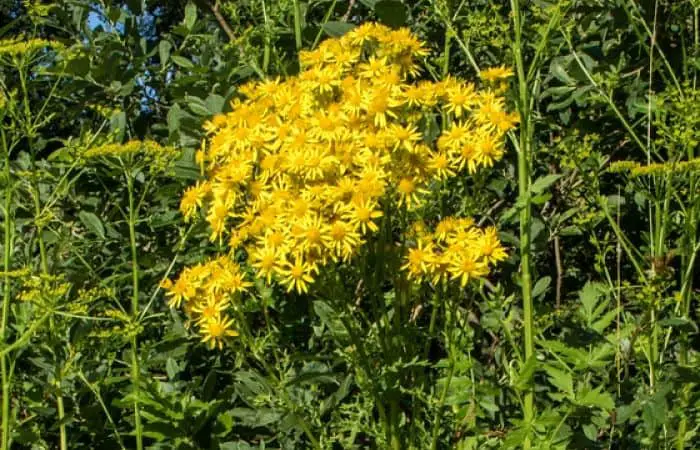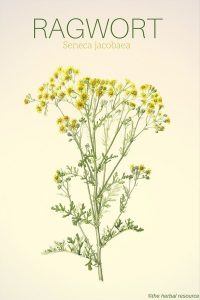Botanical Name: Senecio jacobaea.
Other Common Names: Common ragwort, mare’s fart, tansy ragwort, ragweed, stinking willie, stinking nanny, dog standard, staggerwort, stammerwort, cankerwort, cushag, hierba de santiago (Spanish), herbe-de-saint-jacques, cinéraire (French), Jacobs-Greiskraut (German), eng-brandbæger (Danish), landøyda (Norwegian), stånds (Swedish).
Habitat: Ragwort is Native to Europe, North Africa, Caucasus and Western Asia. The plant has been introduced to North and South America, Australia and New Zealand.
The plants thrive best in dry and rather nutrient-poor soil and can usually be found in cultivated fields, grazing pastures, along ditches and roadsides
The plant is regarded as a troublesome and often very dangerous weed and in some Australian states, farmers and landowners are required by law to the keep the plant at bay or eradicate it.
In New Zealand, farmers sometimes use helicopters to spray their farms with herbicides or they introduce the ragwort flea beetle to the affected area if ragwort is too widespread.
Description: Ragwort is a 40-80 cm tall, bi-annual (can exhibit perennial properties under the right conditions) that belongs to the daisy family (Asteraceae). The plant has erect, stiff and tough stems and thick roots.
The upper part of the stem is usually highly branched and produces many flower heads. The hermaphrodite bright yellow flower heads form dense, flat-topped clusters. The plant is in bloom from June to November (northern hemisphere). Pollination is done by bees, flies, moths, and butterflies.
The green leaves are pinnately lobed and have a rather unpleasant smell which explains some of the plant’s English common names like stinking Willie, stinking nanny and mare’s fart.
Plant Parts Used: In the past, the above ground parts of the plant were used for medicinal purposes. The plant was usually harvested during the flowering period and used fresh or dried for later use.
Health Benefits and Medicinal Applications of Ragwort
Active Ingredients and Substances: Like many plant species belonging to the genus Senecio (ragworts and groundsels), common ragwort contains toxic pyrrolizidine alkaloids (seneciphylline, senecionine, jacodin, jaconine, jacobine, jacozine, otosenine and retrorsine).
Other ingredients in the herb are flavone glycosides, resins, mucilage and mineral salts.
The essential oil extracted from the plant contains germacrene D and 1-undecene as the main ingredients, but it also contains 1-nonen, myrcene, ocimene, and beta-caryophyllene.
Traditional Uses
In the past, ragwort did have some medicinal uses, especially in England.
In folk medicine, the herb was used externally (mixed with pig fat) as an ointment for relieving pain in the arms, hips, and legs.
The plant was also used to treat throat inflammation in humans and in horses. A poultice made from the plant was laid on the throat, or it was infused in water and used as a gargle.
One of the old English names for ragwort is “stammerwort”, referring to the common belief that it could be used to treat stuttering.
Until recently, ragwort extract was used internally as an herbal remedy for coughs and colds.
It was also used in the past to relieve pain related to sciatica, rheumatism, arthritis and gout, often in combination with wintergreen (Gaultheria procumbens) and lobelia (Lobelia inflata). These traditional uses were also know in the U.S.
Ragwort was applied on boils to get them to open up and in some parts of England, a branch of ragweed was worn as protection against a variety of infectious deceases.
Medicinal Properties of Ragwort
Ragwort is closely related to common groundsel (Senecio vulgaris) and has similar medicinal properties and applications.
Ragwort is thought to have purifying, sudorific and antipyretic properties. The plant is also regarded to have cooling and astringent effect.
Ragwort may be useful in treating burns, sores and eye infections and it may also be helpful as a gargle to treat mouth ulcers and sore throat. In addition, it is thought to ease the pain of bee stings.
A homeopathic preparation is made from the plant. It is used to treat a variety of health conditions such as intestinal worms, internal bleeding, menstrual disorders and other female related ailments.
Despite its medicinal properties ragwort is a highly poisonous plant that should never be used internally in any form or externally on open wounds. The plant can also cause skin rashes in sensitive people just by a simple touch.
Dosage and Administration
Ragwort should never be used internally and it is regarded to be unsuitable as a medicinal herb due to its toxicity. So any self-medication of the herb is advised against and can result in serious side effects.
Side Effects, Interactions and Toxicity of Ragwort
Most plant species in the genus Senecio are potentially poisonous, and ragwort is probably the one considered most dangerous.
The herb contains a wide range of toxic pyrrolizidine alkaloids and cyclic diesters. These substances are carcinogenic and can cause severe liver damage (necrosis and cirrhosis) both in humans and animals.
Domestic grazing livestock normally avoids the plant in pasture and fields but hay can easily become contaminated with ragweed and pose serious health concerns. The toxic alkaloids are not destroyed by drying and because the toxins accumulate in the body, small doses ingested over a long period of time can eventually lead to deadly poisoning.
Symptoms of ragwort poisoning in animals are digestion system failure, restlessness, hepatitis, blindness, shaking of legs or leg tremors and eventually total collapse. These symptoms can appear in few days to several weeks or even months. Once the symptoms have manifested, the animals usually die within days.
In the 1930s it was discovered that the so-called “Pictou cattle disease“, a liver disease particularly affecting cows, was due to ragwort.
In several countries, serious poisoning in humans has been reported when food grains have been contaminated with seeds from different Senecio species.
Some researchers believe that the high rate of liver cancer in rural Africa is caused by large amounts of ragweed in uncleaned bread grains.
Symptoms of poisoning in humans can be abdominal pain, nausea, vomiting, headache, enlarged liver, apathy and abnormal weight loss.
People have also been poisoned indirectly by consuming milk or honey that is contaminated with ragwort.
There is no specific treatment for ragwort poisoning, only general symptom relief and treatment of digestive disorders and liver damage.
Like so many plants in the daisy family (Asteraceae), ragwort can cause an allergic reaction (contact dermatitis) in sensitive people.
Supporting References
Barker, Julian: The Medicinal Flora of Britain & Northwestern Europe. Kent, Winter Press 2001.
Bown, Deni: The Royal Horticultural Society New Encyclopedia of Herbs & Their Uses. London, Dorling Kindersley 2002.
Hatfield, Gabrielle: Hatfield’s Herbal. London, Allen Lane 2007.
Stary, Frantisek & Zdenek Berger: Poisonous Plants. Leicester, Magna Books 1995.
Turner, Nancy J. and Adam F. Szczawinski: Common Poisonous Plants and Mushrooms of North America. Portland, Timber Press 1997.
Williamson, Elisabeth M.: Potter’s Herbal Cyclopedia. Essex, Saffron Walden 2003.
Thordur Sturluson
Latest posts by Thordur Sturluson (see all)
- What is the Difference Between Hemp and Marijuana? - June 3, 2019


My great grandfater smoked dry ragwort and other plants in his pipe. He lived to be 96 and cycled up to that age.